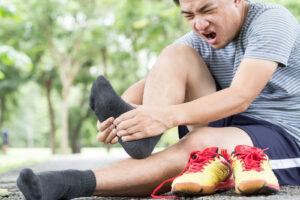A blister is a fluid-filled lesion that develops on the top layer of the skin in response to infection or injury. Blisters usually form around the hands and feet, where the outermost skin layer is thickest. They appear as irregular sore bubbles filled with a clear watery fluid (serum) sticking out of the skin.
What causes blisters on the feet?
Blisters form in the epidermis or dermis layers of an irritated area of the skin to cushion the underlying tissues from further harm. Some of the leading causes of blisters include skin burns, reactions to skin irritants, contact dermatitis, friction and pressure, trauma and certain infectious diseases and disorders (chickenpox, dyshidrotic eczema, herpes, fungal infections, etc.).
Since the foot is constantly stressed from standing, walking and running, fiction burns and excessive pressure on the skin are the most common cause of blisters around the soles of the feet, heels, toes and ankles. Foot blisters can be so painful in these areas that they restrict movement and footwear.
How to prevent foot blisters
Blisters are a common problem for frequent runners, hikers and bikers. Fortunately, they’re surprisingly easy to prevent. Here are some useful tips to keep those annoyingly painful blisters from stopping you in your tracks:
1. Wear the right shoes and socks
A common cause of foot blisters is poorly fitting footwear. Always wear perfectly sized pairs of shoes and socks, even when out for a short stroll. Ensure your heel doesn’t slide from the innersole’s heel cup and the toes do not rub against the front, sides or roof of the shoe. Also, thick socks are not always the answer. Ideally, go for comfortable double-layer cotton socks that pair well with your feet and the particular shoes you’re wearing.
2. Lubricate your feet
Foot blisters usually result from friction between the skin and the shoe. Rubbing lubricant on problematic areas of the foot can help prevent blisters by causing the foot to slide inside the shoe rather than rub against it. Anything from petroleum jelly to sports lube will do, as long as it doesn’t irritate your skin.
3. Keep your feet dry
Keeping your feet, socks and shoes dry drastically reduces the risk of getting blisters. To do this, spray antiperspirant on your feet to minimise sweating or sprinkle corn starch or talcum powder in your shoes and socks to wick up any moisture that might accumulate there. It also helps to carry an extra pair or two of dry socks to change on long journeys.
4. Readjust your shoes for hot spots
Whenever you feel a hot spot on your foot while walking, a blister might be about to form in that area. If that happens, stop and readjust your socks and shoes (innersole, laces and tongue) to see if the burning goes away. You can also protect the hot spot by covering it with lube, tape or a small bandage. But be very careful not to cover or tape an already developing blister because doing so could make it worse.
Bonus tip: handling blisters
Even while observing these preventative measures, a blister can sometimes still develop on your foot. The good news is that most blisters heal on their own in a matter of days. One thing you can do is resist the urge to pop a blister – an open blister can easily get infected. However, you can rub ointments or balms around the affected area to relieve soreness and pain. But if the blisters worsen over time by growing, turning red, discolouring or becoming more painful, you may need to see a podiatrist.
Don’t hesitate to send us a message or call 03 9434 4422 if you’re worried about blisters or other foot-related problems. You can also book an appointment online with our team of highly qualified and experienced podiatrists.
